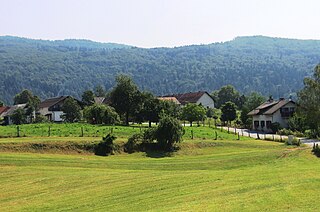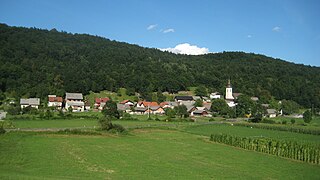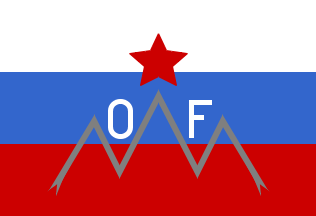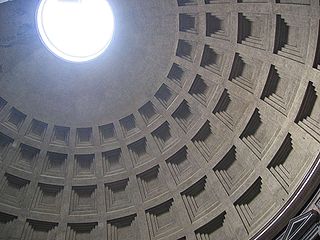
Borovec pri Kočevski Reki is a settlement in the Municipality of Kočevje in southern Slovenia. The area is part of the traditional region of Lower Carniola and is now included in the Southeast Slovenia Statistical Region. It also includes the former villages of Draga, Ravne, Pleš, and Inlauf as hamlets. The former village of Ajbik was annexed by Borovec pri Kočevski Reki on 30 January 1953.

Koče is a settlement in the hills south of Kočevje in southern Slovenia. The area is part of the traditional region of Lower Carniola and is now included in the Southeast Slovenia Statistical Region.

Livold is a village in the Kočevje Polje southeast of the town of Kočevje in southern Slovenia. The area is part of the traditional region of Lower Carniola and is now included in the Southeast Slovenia Statistical Region. The village stretches along the road connecting Kočevje and Petrina, near the turn to Mozelj. It has a pronounced outline. The Rinža River flows through the village; it often goes dry in the summer but floods during heavy rains. There are many karst caves in the area. The Stojna Ridge and Dry Hill rise to the west, and the karstified Šahen lowland lies to the east.

Primoži is a small settlement in the Municipality of Kočevje in southern Slovenia. The area is part of the traditional region of Lower Carniola and is now included in the Southeast Slovenia Statistical Region.

Stari Breg is a settlement in the hills north of the town of Kočevje in southern Slovenia. The area is part of the traditional region of Lower Carniola and is now included in the Southeast Slovenia Statistical Region.

Stari Log is a settlement in the hills north of the town of Kočevje in southern Slovenia. The area is part of the traditional region of Lower Carniola and is now included in the Southeast Slovenia Statistical Region. The village has a cistern and traditional village pond. Raven Spring, a karst spring southwest of the village, is accessible by 13 flights of steps and was once an important site for hunting frogs.

Staro Brezje is a settlement in the hills east of the town of Kočevje in southern Slovenia. The area is part of the traditional region of Lower Carniola and is now included in the Southeast Slovenia Statistical Region.

Zajčje Polje is a settlement in the Municipality of Kočevje in southern Slovenia. It was inhabited mostly by Gottschee Germans. The area is part of the traditional region of Lower Carniola and is now included in the Southeast Slovenia Statistical Region.

Stari Kot is a village in the Municipality of Loški Potok in southern Slovenia, next to the border with Croatia. The area is part of the traditional region of Lower Carniola and is now included in the Southeast Slovenia Statistical Region. It consists of the hamlets of Binkl, Kurja Vas, Pri Ambrožiču, Hrib, and Preska. The main road from Lazec to Prezid runs through the village.

Kočevske Poljane is a village in the Municipality of Dolenjske Toplice in Slovenia. The area is part of the historical region of Lower Carniola. The municipality is now included in the Southeast Slovenia Statistical Region. The village includes the hamlets of Gorica and Trnovec.

Hrib pri Koprivniku is a remote almost abandoned settlement in the Municipality of Kočevje in southern Slovenia. The area is part of the traditional region of Lower Carniola and is now included in the Southeast Slovenia Statistical Region.

Suhi Potok is a settlement in the Municipality of Kočevje in southern Slovenia. The area is part of the traditional region of Lower Carniola and is now included in the Southeast Slovenia Statistical Region.

Ravne is a remote settlement in the Municipality of Kočevje in southern Slovenia. The area is part of the traditional region of Lower Carniola and is now included in the Southeast Slovenia Statistical Region. Its territory is now part of the village of Borovec pri Kočevski Reki.

Kleč is a settlement in the Municipality of Kočevje in southern Slovenia. The area is part of the traditional region of Lower Carniola and is now part of the Southeast Slovenia Statistical Region. It no longer has any permanent residents.

Gradec is a remote abandoned settlement in the Municipality of Črnomelj in the White Carniola area of southeastern Slovenia. The area is part of the traditional region of Lower Carniola and is now included in the Southeast Slovenia Statistical Region. Its territory is now part of the village of Rožič Vrh.

Vimolj is a remote abandoned settlement in the Municipality of Semič in southern Slovenia. The area is part of the traditional region of Lower Carniola and is now included in the Southeast Slovenia Statistical Region. Its territory is now part of the village of Srednja Vas.

Rog is a remote abandoned settlement in the Municipality of Kočevje in southern Slovenia. The area is part of the traditional region of Lower Carniola and is now included in the Southeast Slovenia Statistical Region. Its territory is now part of the village of Trnovec.

Žiben is a remote abandoned settlement in the Municipality of Kočevje in southern Slovenia. The area is part of the traditional region of Lower Carniola and is now included in the Southeast Slovenia Statistical Region. Its territory is now part of the village of Pugled pri Starem Logu.

Topličice is a remote abandoned settlement in the Municipality of Semič in southern Slovenia. The area is part of the traditional region of Lower Carniola and is now included in the Southeast Slovenia Statistical Region. Its territory is now part of the village of Sredgora. It lies in a narrow dry valley 1 km east of Sredgora.

Cesta is a former settlement in the Municipality of Kočevje in southern Slovenia. The area is part of the traditional region of Lower Carniola and is now included in the Southeast Slovenia Statistical Region. Its territory is now part of the village of Pugled pri Starem Logu.













